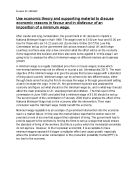Alfred Marshall (1842-1924) and Leon Walras (1834-1910) are two of the most renowned neo-classical economic theorists, who contributed a great deal to the contemporary economic analysis.
Alfred Marshall (1842-1924) and Leon Walras (1834-1910) are two of the most renowned neo-classical economic theorists, who contributed a great deal to the contemporary economic analysis. Leon Walras was born in Normandy, France, and was later accredited as the originator of general-equilibrium analysis. He, along with Jevons and Menger, are classified as the originators of the Marginal Utility principle; which boosted his reputation. Alfred Marshall, on the other hand, was not the son of an economist, rather his dad was a bank cashier. He was born in Clapham, England in 1842. Their individual works; Walras’s Elements of Pure Economics (1874), and Marshall’s Principles of Economics (1890), were very dissimilar. Yet they did share some similarities. For instance, both of them incorporated stability into their analysis, and were greatly influenced by Cournot’s use of differential calculus in economics.
The essential difference between the two lies in their utilization of different conventions when dealing with markets. Marshall utilized the partial-equilibrium analysis, in which markets are said to be in quasi isolation. Walras, on the other hand, developed and used general-equilibrium analysis. Both Marshall and Walras agreed upon the determination of equilibrium price and quantity by means of the demand and supply function intersection. They did have some conflicting views in regards to the determinants of the supply and demand function, and the technicalities of market equilibrium.
Considering the orange juice example in the textbook (A History of Economic Thought and Method, chapter 15,page 383), Marshall placed a great deal of emphasis on the ceteris paribus assumptions. He assumed the demand for orange juice was determined not only by the price of orange juice, but also by the prices of its substitutes and complements, and the tastes and income of the consumers. All the other factors are assumed constant as per ceteris paribus. He did this so to isolate the market for closer assessment. In contrast, Walras was interested in the interdependencies between markets, and did not disregard the vaguely related determinants of the price and quantity of any particular good, like orange juice in our case. He considered the ceteris paribus assumptions used by Marshall as improper, and asserted that other factors could not be considered constant. Walras and Marshall seemed to differ in their analysis partly also because they focused their books onto different audiences. Marshall’s audience was comprised of the typical clever business person, and so in his book Principles he outlined the tools and uses of economic analysis. Walras, in contrast, aimed his book Elements onto his professional colleagues.







